Anki Pro Tips for Language Learners (a FAQ)
We like using Anki, a flashcard app, to drill in words. Since we use it so much, I thought I’d put down these Anki pro tips for language learners.
Swahili is my ninth language and Jo’s fourth, and by now we’ve figured out how to use Anki and flashcards.
Anki is the original flashcard app, around for over a decade. It’s free (open source), it’s very powerful, and it syncs to a free mobile app.
Anki is so widely used you can buy flashcard decks from many major websites and publishers, like from Lingualism for example.
Unfortunately, Anki’s interface is not intuitive. Most modern software doesn’t need a manual, but Anki’s user manual is massive.
Don’t read the Anki user manual though; read these tips first.
If you just want to get started with Anki, then read this guide to getting started first.
Become a Discoverer.
Want to get more tips on language learning, cultural exploration and immersive learning? Sign up to our newsletter. “Good things sometimes, not everything all the time”, that’s our motto.
Onward to the Anki FAQ. Enjoy!
Contents
Should I use Anki or another flashcard app?
Short answer: Use Anki. The interface is a little old, but it’s still the best for lots of reasons, and worth the brief learning curve.
Anki has been around for a long time. It doesn’t have the best interface (which is why you even need this FAQ), and there are “cleaner” flashcard apps out there.
But there’s a few good reasons we still recommend it, after trying dozens of others.
Anki for desktop is free and open source. The desktop app is free, and is where you should start, and could be all you need.
The Android app is free, but you do have to pay for the iOS app (but it’s worth it).
You can get lots of Anki decks online. For whatever language — Arabic, Chinese, Spanish — someone has made a deck out there and usually shares it for free.
You have to pay for the very best ones, but it’s worth it to get quality, up-to-date and error-checked decks. You can also share your decks later 🙂 (but don’t share ones you’ve bought!)
See below for a few of our favourite starter decks.
There are many Anki-compatible apps. If you later want to use another app, but just use Anki as the back-end, you can (but you don’t have to).
Anki is so “standard” that many apps are designed to sync with Anki. They assume you use Anki to manage your database and want to let you keep doing that, and just provide a glossy surface on top.
You can learn how to use Anki in 30 minutes. These days I know people are impatient. You want to (and expect to be able to) open an app and know how to use it instantly. You need to figure Anki out. But that’s why we’re here (and why the Internet is in general).
There are lots of cool plugins for Anki, like AwesomeTTS (the only one I use, but I adore it) to add audio quickly to your flashcards.
See this guide to using AwesomeTTS and Microsoft Azure to add audio to your flashcards for free (effectively).
So in summary, despite it being a little “2000s” in interface design, Anki is still the best. Use Anki.
Can I do multiple languages at the same time in Anki?
Short answer: focus on one language, don’t study more than one at a time intensively.
This is subjective, but I think it carries weight as we’ve studied many languages.
In our experience, as well as in the experience of 90% of successful language learners we know, there’s great power in focusing on one language at a time.
I would not recommend studying two languages, whether they’re similar languages (e.g. French and Spanish) or totally different (e.g. French and Chinese).
You may wish to maintain another language. This is different, and I think totally fine. Just make sure you’re not adding new cards to that deck, otherwise you will quickly run out of brain space.
Should I make my own Anki deck, or buy one or download one?
Short answer: Make your own deck, but you can use other pre-made decks as input or support.
Making a deck is the best way to learn, but it can be very laborious coming up with all your own words and sentences. If you find an excellent publisher for a language, then I heartily recommend downloading a deck and learning that.
The best place to start is the Anki shared decks online. These are free and amazing!
For example, the “Chinese Words and Sentences, Spoon Fed” is well regarded on language learning forums as being the greatest Chinese Anki deck of all time. It has examples and even audio for many, many words.
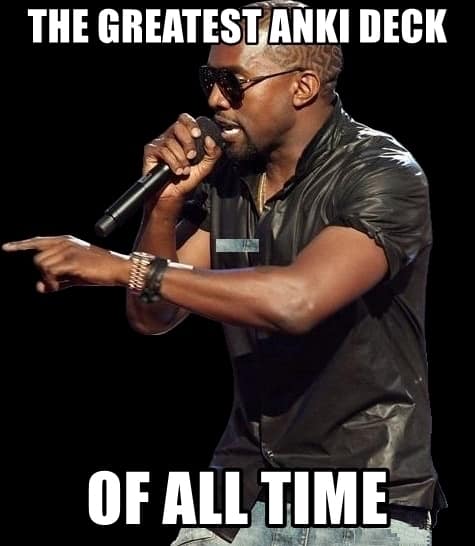
Here are a few good reasons to start with another deck:
- Making a deck is not the same as studying, even though it’s in a similar mental space. Just like building a motorcycle isn’t the same as practising riding.
- Even though you want to learn what’s important to you, there are many similar people to you out there. And if a deck is 70% aligned with you, it’s easy to just skip/suspend cards that you think are irrelevant.
- Even if you buy an Anki deck (like from Lingualism, for Arabic), you’re buying hundreds of hours of someone else’s time, and saving even more time for yourself, for less than $20. GREAT deal.
What are some great starter decks for languages you know or are learning?
I didn’t use Anki until Swahili, shockingly. Even though I’ve known of Anki’s existence since 2011 (and I tried it for Chinese, but I didn’t use it much).
But still, I’ve done some research and found great starter decks for languages we know/are studying.
- Egyptian Arabic: Matthew Aldrich’s Egyptian Arabic deck, with many colloquial words and sample sentences, available from Lingualism for $16.99 (other Arabic dialects available too)
- Mandarin Chinese: Chinese Words and Sentences, Spoon Fed (free)
- Hebrew: 100 Hebrew Verbs from TeachMeHebrew. Verbs are very important in Hebrew.
- Farsi: 504 English to Farsi, a great deck of words with many sentences
- Korean: Evita’s grammar and vocabulary decks, very rich content with audio (and free)
- Swahili: We did not find any good ones! I’ll make a deck public — check out our Swahili resources page, where I’ll make it available.
There are good decks for Italian, French, Spanish (and of course learning English from any of those languages) but I haven’t gone hunting yet as those languages are just on maintenance. If you have one you love, let us know in comments.
How many new cards should I study a day to learn a language?
Short answer: Add about 5 a day for a light pace, 10 a day for a medium pace, and 20 a day for a heavy pace.
(Updated in 2021 after a lot of experimentation.)
The number of cards you should add every day depends on what you’re studying and how hard you find each card. But that’s a general guide. For many languages, I find 10 new cards a day to give me about 30 minutes of work.
Remember, adding 10 means you’ll probably study 50-100 cards a day. There’ll be 25 new cards, but still reviews from the previous days.
On top of that, every time I add or review cards, I find myself editing cards, adding new cards to help learn old ones, and so on.
The number of cards you review grows cumulatively, and a session can include 100 reviews or more, which can each take a while as you realize “Hey, I don’t know how to use this word, I should write a sentence”, or “I’m having trouble learning this word and need to learn it another way”.
In the beginning, the words you’ll add will be easy, like numbers and greetings. It won’t feel like a burden because you’ll learn them quickly through other means. You should aspire to learn about 25 new words every day if you’re trying to learn a language reasonably quickly. You could learn more, but you also have a lot of grammar and sentence structures to learn.
After a couple of weeks, you can increase to fifty. Be warned though, this will increase your study time to about two hours!
Learning 100 a day is probably too aggressive (unless you’re cramming for an exam, and not trying to learn). I wouldn’t recommend this. The only time this is OK is when you first add your deck, if you didn’t do it the first moment you picked up the language… you want to churn through the few hundred words and whittle down your deck quickly.
After a month at this pace, you’ll have a vocabulary of about 1000, which is enough to get by.
I looked around the web for other language learners using Anki, and found similar results: aggressive, full-time learners would even out at 50-100 a day, and keep on pace to learn thousands of words in a few months. But I’d only recommend this if a) you want to get to a professional translator level and b) the language you’re learning needs lots of memorisation, like Chinese or Arabic.
10 is kind of lazy. Are you serious? Do more cards!
How much time should I spend doing Anki flashcards a day?
Short answer: Do flashcards for 30-60 minutes a day as part of a normal study schedule involving other stuff.
General consensus from the internet is 30-60 minutes a day, or around 150-300 cards. This equates to adding 25-50 cards a day. (Sources: Reddit, various language forums, and an online Anki calculator).
I personally do about 30 minutes of Anki study per day on my target language, and then a few minutes each on my other languages (my past ones I’m maintaining, or ones I’m doing for fun over a long period of time).
It’s not just that your brain gets tired. There are other things you need to do in the day, whether you’re spending a lot of time language learning, or it’s part of a broader life. If you’re commuting to work, you likely only have around 30 minutes to do flashcards in a day.
You don’t want to drown and feel “behind” later. And if you’re learning language intensively, you need time for speaking, reading, homework and watching TV shows and movies etc.
And of course you can do less. For some languages I just do about 20 cards a day in a few minutes. Those are for languages I’m not really worried about too much, and just want to build up general familiarity over the next few years. (See my article on learning a language slowly in just one sentence a day).
What’s the most effective kind of card or note?
Short answer: Notes with a sentence, translation, and audio. Pictures if you get stuck. Two cards per note, with opposite prompts. words, pronunciation, and sentence examples.
My favourite kind of note (see above for card vs note) has:
- A sentence in English (my most fluent language)
- The sentence in my target language
- Audio
- Two cards, one for each side (English –> Target, and Target –> English)
- Optional: a picture
The picture is only optional because I only use them if I’m really getting stuck on a word, as one of our tips for when you get stuck with words.
Pictures don’t even work for most words (like verbs). But they can help as mnemonics.
I’ve heavily revised this over time. I used to use one-sided cards, and used to write in the pronunciation.
But I’ve changed to an approach of learning sentences rather than words, and use audio on every card (in the target language only).
How do you sync Anki over the air between mobile and computer?
Short answer: Create an AnkiWeb account and download AnkiDroid (or you can buy AnkiMobile for iOS, but it’s US$24.99).
Syncing is one of the best bits that has really gotten better over the years. It’s not perfect, but it’s free and it works. (In the dark ages, you could only sync to a web interface, and it was done via Dropbox).
You need to download AnkiDroid, and create an account with Ankiweb. If you have an iOS device, you have to find another app on the app store (there are free ones, but I don’t think they’re totally free like AnkiDroiid is).
You also need to sync every time you switch devices, which can get tiresome. Like when you finish a session on mobile, and want to use desktop next, manually sync your mobile session.
What’s the difference between a “Card” and a “Note”
Short answer: You create a “note”, which is a collection of information, and that note has one or more corresponding “cards”, which you study.
If you just study one way (e.g. English –> Spanish), a note and card are the same thing.
A note is a group of information, like 1. a word, 2. its pronunciation, and 3. its meaning.
A card is a flashcard that prompts with one information item, and asks you for another.
With many of my decks, cards are just one-way. Like they’ll say “destructive” in English, and I have to come up with the Persian word (and a sentence) for “destructive”.
But you can also do two-way (or more) cards. For example, for one of my Chinese decks I create a note that has three fields
- Chinese written in characters, like “人不可貌相”
- Chinese written in romanisation: “ren2 bu4ke3 mao4 xiang4”
- English sentence: “You can’t judge a book by its cover”
Then I have cards that prompt me with one of the three, and ask me for one of the others.
When should I “Bury” a card, and when should I “Suspend” it?
Short answer: Bury is to hide it for a day; Suspend is to hide it forever.
If you don’t want to see a card for another day, you “bury” it. Do this when you know you can’t get it right, but plan on practising it, and want it out of the way.
If you don’t want to see a card again (because you get it, you know how to say the number “one” already!), you can “suspend” it.
How do I import a deck from Google Sheets?
Short answer: Three columns: Target Language, English, and Tags. Click “Import” and make sure you’ve chosen the right deck.
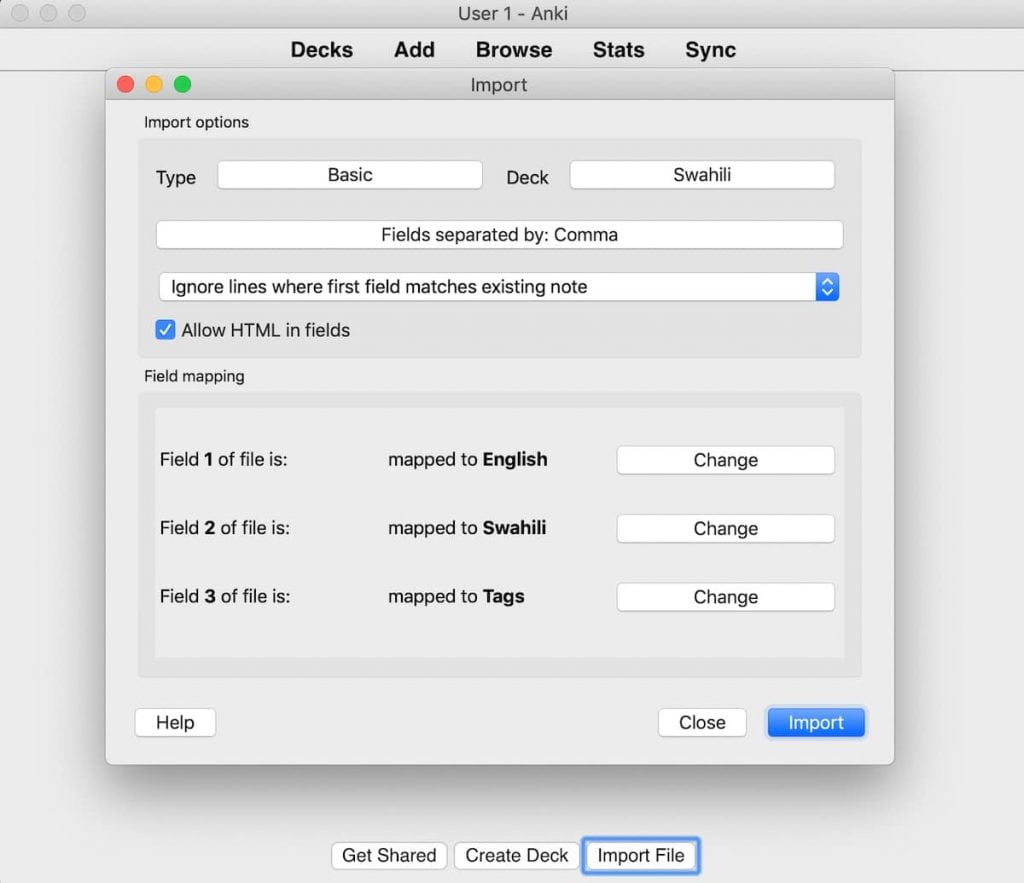
What are the best Anki add-ons for language learning?
This is subjective — I can’t give you an Anki pro tip on add-ons because everyone has a different learning style.
Head over to the list of Anki add-ons and sort them by the most popular.
I only use one add-on (at time of writing) and that’s AwesomeTTS. That’s a plugin that lets you add audio to your flashcards using natural “text to speech” services. I really like it, but it’s also the only one I use!
I have lots of categories of words (like “Food” and “Clothing”), should I make decks, or use tags?
Short answer: Don’t bother with tags or your life will become categorisation. But if you must, use tags to separate themes of words, not decks.
So you’ve diligently been making lists of words in your notebook or Google Sheets.
Now you have a bunch of words under lists like: “Household”, “Verbs” and “Describing People”.
If you made a bunch of decks, you could study them individually. That way, you could easily just study one category of words.
However, Anki recommends using tags to categorise your words with tags rather than decks. From the Anki user manual:
- Lots of little decks mean you end up reviewing cards in a recognizable order… you’ll end up seeing all the “food verb” cards together. This makes it easier to answer the cards, as you can guess them from the context, which leads to weaker memories.
- Anki was not designed to handle many decks, and it will slow down as you add more.
What they recommend instead is tags. Instead of using “Food Nouns” for example, you tag each word with “Food” as well as “Noun”.
Then you can use Anki’s custom search feature to create custom study decks.
Personally I don’t like to use tags. It has its uses, but it becomes an administrative burden to manage my tags and can be a distraction.
How can I study just listening in Anki? (Or reading?)
At some point, you might think “I really have to just practise listening/reading”.
I think we have do much more listening than speaking, something like a 4:1 ratio at least. If you read a lot (even if it’s just menus), then you may also want to focus more on reading.
The way to do this in Anki is to make a filtered deck that only shows you one of card in the note.
For example, I created a filtered deck for a language and added the filter “card:2”.
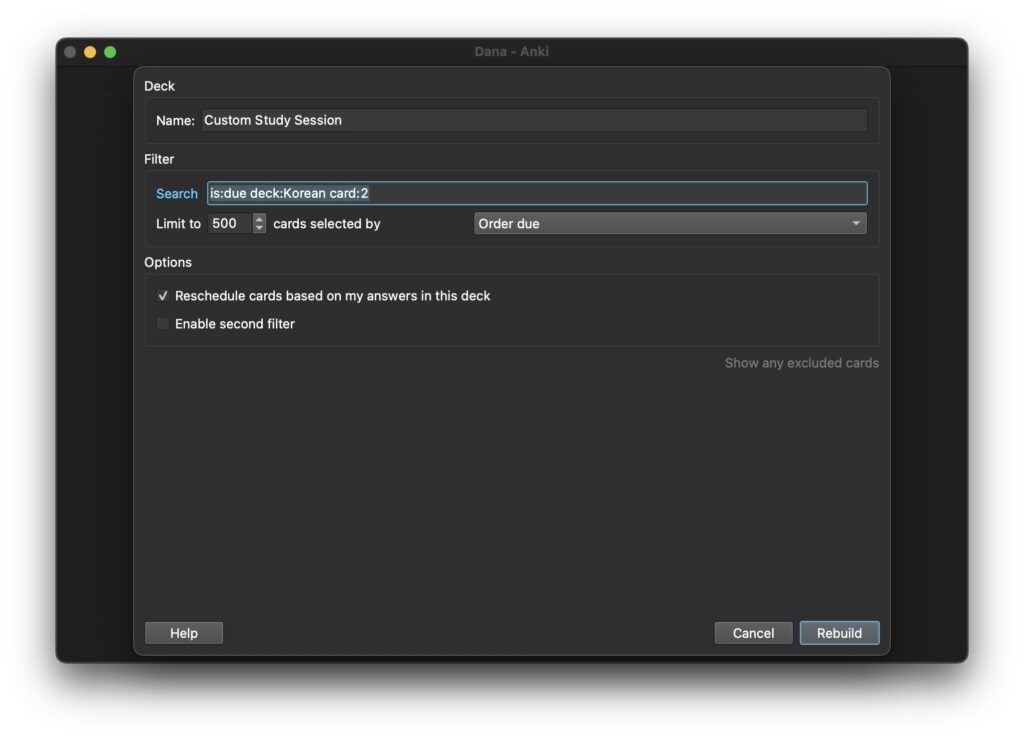
The full filter I used is: “is:due deck:Korean card:2”.
What are the best Anki clients to download and use?
Short answer: the free app on Anki’s website, AnkiDroid (free), or AnkiMobile (paid).
For Mac, Windows, or Linux, use the free apps available on Anki’s web site.
For Android, use AnkiDroid. It’s free, but not built by Anki. However, the interface is much better than Anki’s own interface! It’s cleaner and easier to use, plus only contains what you need to know.
Many people just use the Android app. (Personally, I find it too troublesome adding and editing cards in the app. But I’ve done it.)
For iOS, you have to buy the AnkiMobile iOS app. It’s US$24.99. By paying for it, you’ll be supporting the free Anki software, plus Apple shareholders.
If you’re not sure yet and are still just testing Anki out, you can use the web interface for Anki on your iPhone. It’s not as nice, and it needs an internet connection, but it’s free.
If you’re wondering “Is AnkiMobile worth the $24.99?”, people have asked this question many times before. The short answer is: Anki is the one app that language learners all need. Yes, if you’re serious about learning, it’s worth it. It costs roughly what a language textbook costs, or a fraction of your graduate education costs.
I grew up in the age of no apps, then free apps, then living on a modest budget, so buying apps is hard. But if you find yourself using the desktop app after a couple of months, you won’t regret buying the app.
Got more questions, or an answer to share? Drop them in comments below and we’ll answer them for you and everyone else.

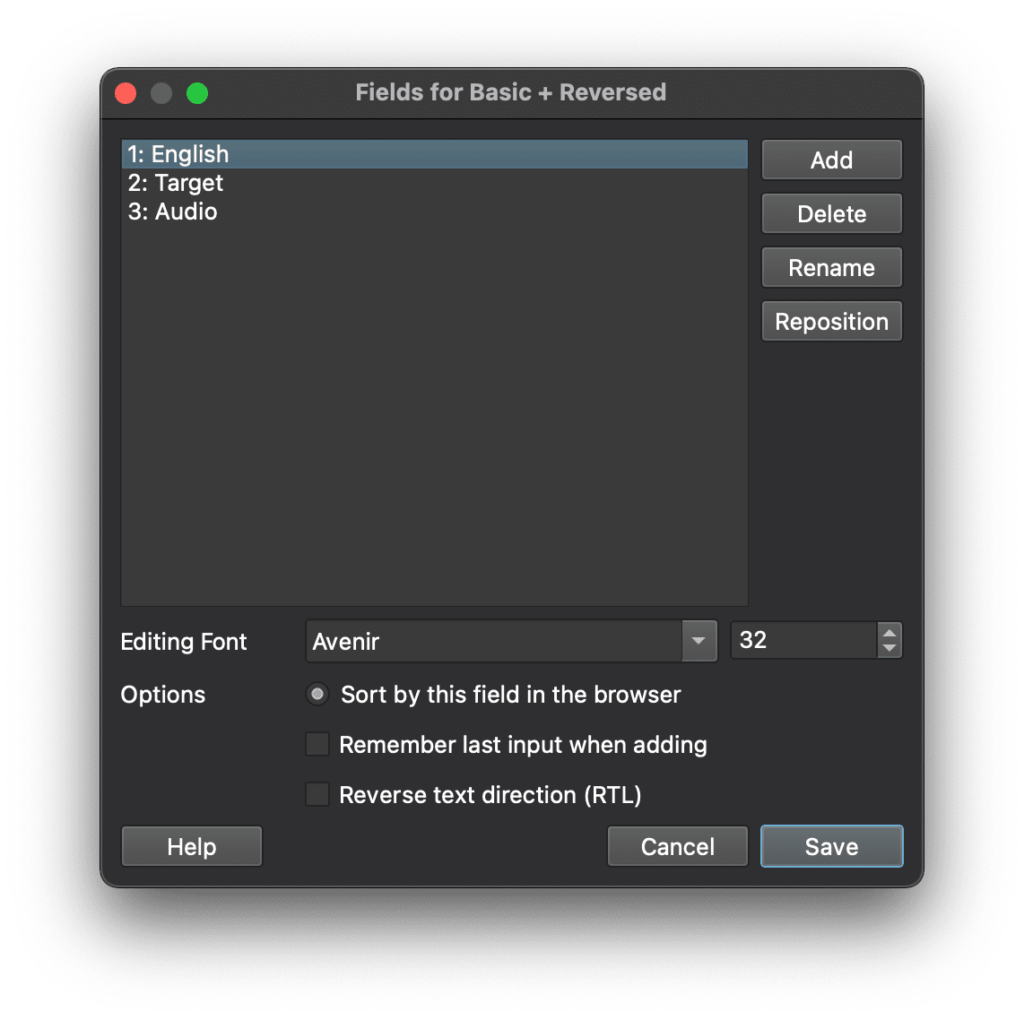
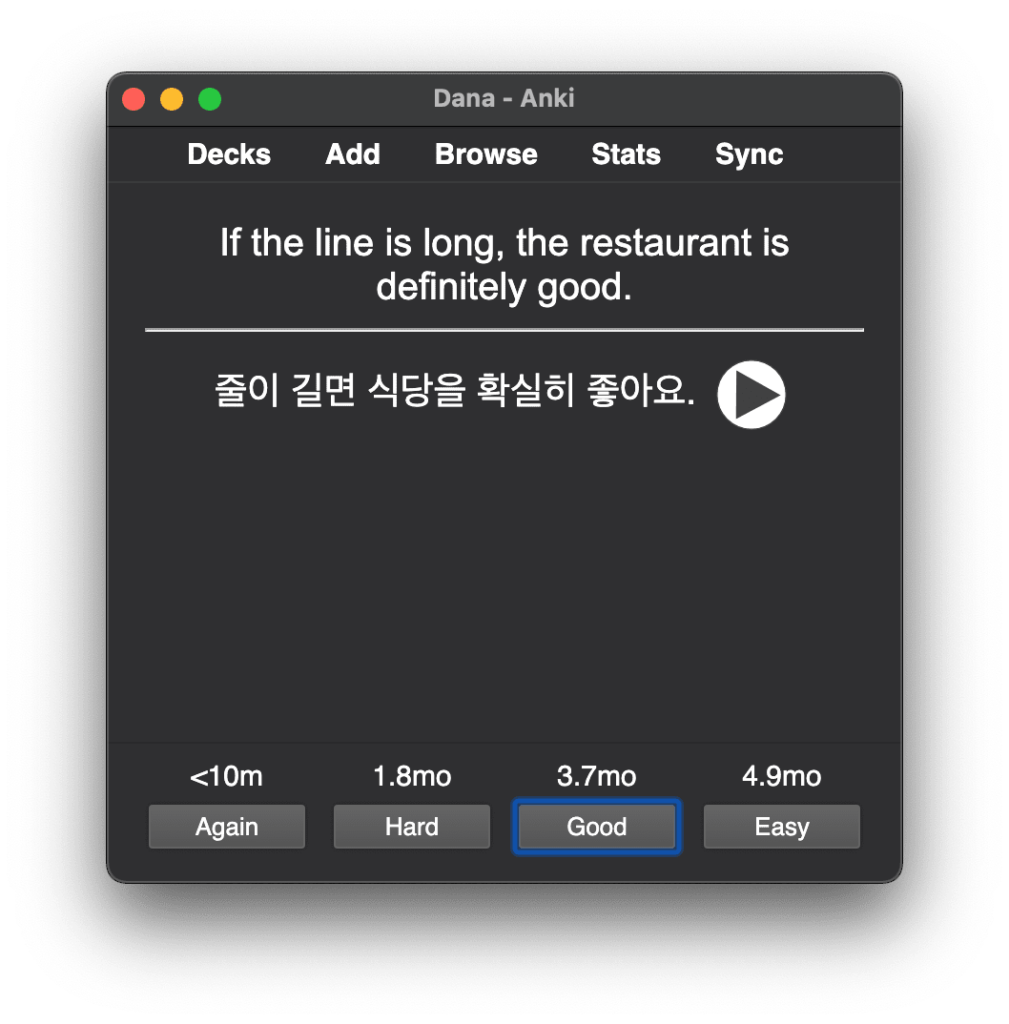
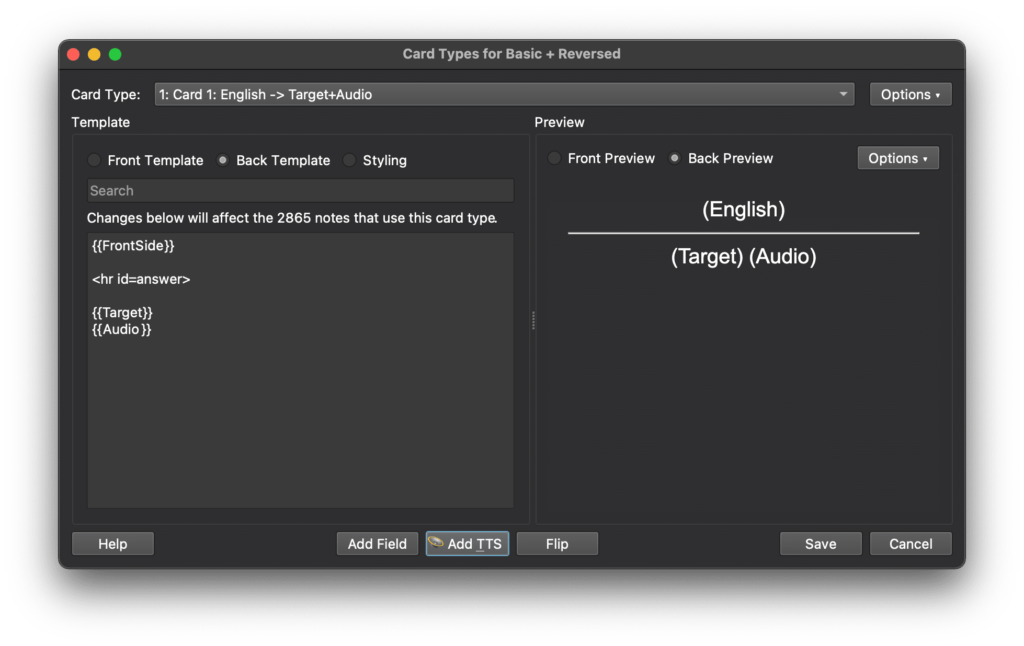





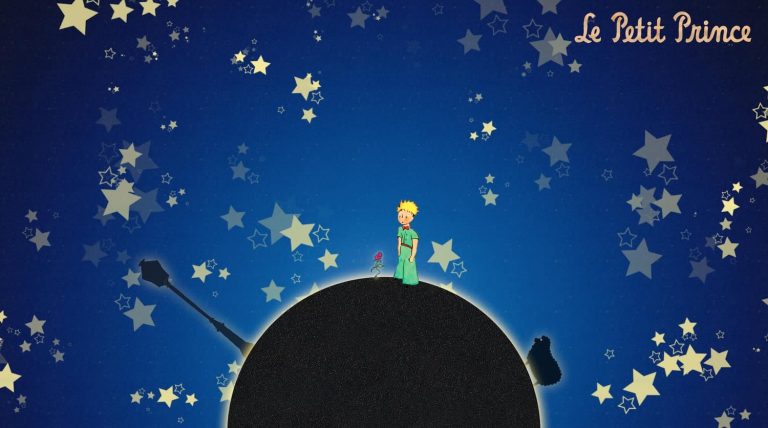
did anyone contact you about great spanish decks?
Not yet – got one?
I’m actually putting together an article on how I’d study Spanish if I were doing it again from scratch so I’d love a reference!
Best deck for French that you recommend?
Great review! Maybe you should add some information about add-ons? I have so far 7 of them, they are very helpful. Also, my mistake that I set 75 new words per day, it is just unreal to accomplish so I started to skip it altogether, thanks for pointing that out in your review. I’m learning Slovak 🙂
This is a great idea. I started looking into add-ons and plugins only recently. The next thing I wanted to write about was designing my own notes and cards.
What plugins do you use?
Slovak sounds like an awesome challenge! What’s your mother tongue?
Thanks for the review. I’m trying to make a decision on Anki vs. Quizlet. The UI is the big draw for Quizlet, but Anki’s ability to attach a sound file is essential for what I’m doing. What is it that I’m trying to accomplish? I work in a village in Alaska whose language is almost extinct. I have learned some and am working with the school to create a language elective for grades 6-12. I found a literacy exercise in the local archives. It contains an L1 speaker in 1976 recording 10 words for each of the 40 sounds in… Read more »
Hi James, your project sounds super cool, and I’m happy to help (you can email us if you want to get into a conversation bout any aspect of it). On the whole, Anki might not be good for the kids. But let me address your questions. Firstly, you can adjust the way you use Anki. You can choose to add no more cards a day, or a few new ones, or many. It’s very configurable. Secondly, it’s important to note that the iOS app is not free. It might be out of the budget of the kids. I recall it… Read more »
Wow, these are great tips! I didn’t realize most people average so many cards in a comparatively short amount of time. Even thirty seconds per second can be a real challenge for me. Guess that just means I need to study them more. Looking forward to applying these tips in the future.